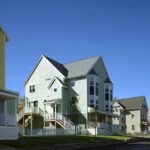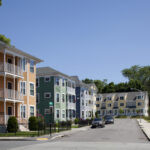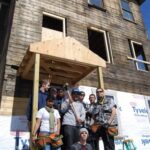History
Our story starts in 1986
Our History
The Main South CDC was incorporated in 1986 due to residents’ concerns about the economic decline and increasing shortage of affordable housing in the Main South neighborhood. The Main South CDC has grown substantially since its inception and has repeatedly proven it has the capacity to translate community priorities into tangible and sustainable change. To date, the agency has developed 400 units of housing, sold 71 homes to first time homebuyers, owns and manages approximately 250 affordable rental units, and has facilitated a wide-variety of community programs intended to improve the quality of life and economically empower Main South community members.
The first act of this new group was to commission a planning study of the area to analyze the socioeconomic characteristics of the various sub-neighborhoods within Main South, and to offer recommendations about a realistic but strategic approach to combat the ongoing disinvestment and social problems that were negatively impacting the quality of life for residents and threatening the economic viability of Clark University. As a result of this study, prepared by Don Chamberlayne in 1985 and entitled “A Planning Study of the Neighborhoods of Main South,” the group of activists decided that they needed to establish a capable development entity that implemented the plan’s recommendations, promoted desirable neighborhood change, and was accountable to the community that it served.
A grant application was prepared and submitted to SEEDCO for grant funding to finance the creation and initial staffing of such an organization. Through this, the Main South CDC was established and has subsequently enjoyed a long and successful working partnership with Clark University. The tangible benefits of this partnership are visible in over $50 million of new investment within the Main South area.
The Main South CDC’s neighborhood revitalization efforts have always been based on a strategic development approach and over the years have evolved through what can be categorized into 17 four distinct strategic planning phases. The last of which is the Main South CDC’s current CIP which was adopted by the organization’s Board of Directors in 2013.
Beginnings: 1985–1986
In 1985, residents and leaders of the Main South community formed a working group to address shared concerns about the socioeconomic and physical decline of the neighborhood. The first act of this group was to commission a planning study to analyze the socioeconomic characteristics of the various sub-neighborhoods within Main South and to recommend strategies to combat ongoing disinvestment and social problems. Prepared by Don Chamberlayne, this study illuminated the need to establish a capable development entity to implement their recommendations, promote desirable neighborhood change, and be accountable to the community. Initially funded through a SEEDCO grant, the Main South CDC was established and incorporated in 1986 and became a staffed organization in 1988. Over the years, the CDC has partnered with a variety of organizations to facilitate positive change in the Main South community, some of which include the Boys and Girls Club, Mass Development, the Regional Environmental Council (REC), Clark University, the Main South Business Association, the YMCA of Central Massachusetts.
Phase 1: Property Acquisition:1986–1995
In its first decade, Main South CDC’s strategy was to concentrate on the targeted acquisitions of “problem properties” along the Main Street corridor. During this period, the agency acquired and renovated 186 housing units at a development cost of $9.5 million, establishing it as a credible development agency.
Phase 2: UPP & Strategic Development Approach: 1995–2000
In 1995, the Main South CDC’s Board of Directors expanded the agency’s scope of work to address both physical and community development in five key areas — physical rehabilitation, economic development, public safety, social and recreational opportunity, and education.
The University Park Partnership (UPP) Revitalization Initiative strengthened and formalized the relationship between the Main South CDC and Clark University. and the Main South CDC. With the funding of a $2.4 million HUD Joint Community Development Grant, this partnership expanded their work and leveraged over $11 million of private investment into the community. The UPP launched several programs for Main South residents and businesses such as the small business loan program, the first-time homebuyers’ program, computer training, and a homework center. UPP also seeded the University Park Campus School, a nationally highly ranked public high school that provided educational opportunities to local youth and increased the number of first-generation college students from the area.
The Main South CDC additionally pivoted its approach from acquiring scattered sites to comprehensively redeveloping entire blocks. Targeting 9 abandoned, fire-damaged buildings, the 2000 Beacon-Oread Redevelopment transformed one of the most troubled and blighted streets in the neighborhood into safe, high-quality, and aesthetically pleasing housing.
Phase 3: The KGH Neighborhood Revitalization Project, 2000–2013
The success of the Beacon-Oread Redevelopment project heavily influenced the third phase of Main South CDC’s work, the Kilby-Gardner-Hammond (KGH) Revitalization Project. In collaboration with Clark University, the Boys and Girls Club, and the City of Worcester, the agency reclaimed a 30-acre blighted section of the neighborhood that had over 40 vacant lots, $600,000 of property tax liens, and a 7.8-acre industrial brownfield. Through multiple construction phases and an estimated $32 million investment, the KGH project produced 107 affordable housing units (58 new and 49 renovated), including 44 units sold to first-time homebuyers.
The project additionally supported the construction of new community facilities. A renovated Boys & Girls Club building opened in 2006, and the Main South CDC established their Center for Revitalization on Main Street. Utilizing a $2.4 million Federal Highway Grant, a new bike path and retaining wall were completed in the Spring of 2015, and Clark’s athletic facility was completed in 2016.
Phase 4: Main South BCJI Project, 2014–2018
Funded by a Department of Justice grant and supported by partnerships with the Worcester Boys and Girls Club, Clark, and the Worcester Police Department (WPD), the Main South Byrne Criminal Justice Initiative (BCJI) Project comprehensively addressed the physical, social, and gang-related disorder that had persisted in the neighborhood for decades. The BCJI project was rooted in their Theory of Change, which states, “When residents feel safe and able to use public spaces, and when youth have access to recreation and resources for fun and success, it creates a positive environment where gang violence, crime, and social disorder are reduced.”
Throughout the project, Main South CDC created opportunities for community engagement. The agency implemented 45 (18 recurring) free, family-friendly events and programs in University Park. Over two years, the programs reached over 8,000 attendees, who came together to celebrate culture and access local food, fitness, and entertainment. The BCJI project additionally created two street outreach programs, the Main South Youth Corps and the Youth Outreach Workers, which empowered local youth with jobs, resources, and skills. During this period, the Boys and Girls Club increased their field activities and were able to boost local membership. A seven-week Youth-Police Dialogue Program worked to build relationships and trust between Main South youth and police officers. Subsequent surveys demonstrated increased empathy and engagement between the two groups as a result of the program. The CDC additionally continued targeted physical revitalization efforts, helping to expand affordable rental and homeownership opportunities for Main South residents and to beautify the neighborhood.
The BCJI project had a significant impact on crime and safety in the area. In addition to an overall decrease in juvenile arrests, there was a 76% decline in arrests and an 83% reduction in crime victims in University Park from the start to conclusion of the program. A door-to-door survey additionally found a 44% increase in perception of safety.
Phase 5: TDI and Commercial Corridor Revitalization, 2018–Present
Main South CDC served as a lead partner in Mass Development’s Transformative Development Initiative (TDI)’s work in the Main Street Commercial Corridor between 2018 and 2022. The TDI partnership helped to establish an organized, diverse association of local, primarily BIPOC and Latinx business owners (the Main South Business Association) to promote economic prosperity. Main South CDC provided technical and financial assistance to support the creation and growth of the MSBA and is continually working to address the needs of local businesses to recover, stabilize, and grow after the COVID-19 pandemic.
While Mass Development has moved on to another TDI district in Worcester, Main South CDC is continuing the work that started in 2018 of making physical, economic, and social improvements to the commercial corridor. The agency is currently developing a set of affordable commercial condominiums on the vacant lot at 807 Main Street. In addition to improving the physical appearance of blighted and vacant lots on Main Street, this initiative aims to ensure economic stability and establish generational wealth for local businesses through affordable commercial ownership opportunities.
Main South CDC has additionally completed a significant new development at 92 Grand Street that offers 48 residential and 2 commercial apartments. The agency received over 1,700 applications for the 48 residential units, illustrating the continued need for the development of affordable housing.

















